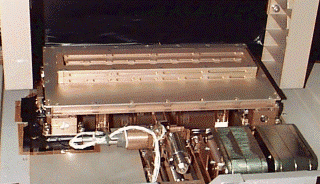FUSE Detector: The FUSE detector was constructed and tested at the University of California, Berkeley. This is one of two detectors before installation in the FUSE spectrograph. The detector is in a vacuum chamber to protect agains the Earth's atmosphere. A door at the top chamber was opened after the FUSE satellite reached orbit. The vacuum chamber is 235 mm across (about 9 inches).
Credit: University of California, Berkeley / Johns Hopkins University / NASA
With the early ultraviolet astronomy experiments came the development of the technology: detectors that could detect the very short wavelength radiation, that could survive the rigors of launch, and that could operate in space, among other things. These weren’t easy things. The available detectors from ground-based laboratory experiments used high voltage and included thin, delicate parts that might easily break at launch because of the vibrations caused by the explosive launch of a rocket. Many of the attempts to use these early detectors in space were disasters. It took a long time before people learned how to use them successfully.
It was about the same time that the use of electronic detectors was understood, in the 1960s, that I got my first taste of ultraviolet astronomy. I was on a learning curve, but that was good, because everybody was. There were a lot of us at Johns Hopkins at that time who were novices, but we worked together.
I started working in the field very early in its history and watched it grow into a sophisticated field over a span of forty years. In particular, the most recent detectors launched into space on the Hubble Space Telescope mission and the FUSE mission, for which I was a principal investigator, are very sophisticated detectors. FUSE was a follow-on mission to the Copernicus mission I mentioned before. The telescopes for the Copernicus and FUSE were about the same size. However, because FUSE used modern detectors, it was about ten thousand times better at gathering data and could see much, much farther than Copernicus.


